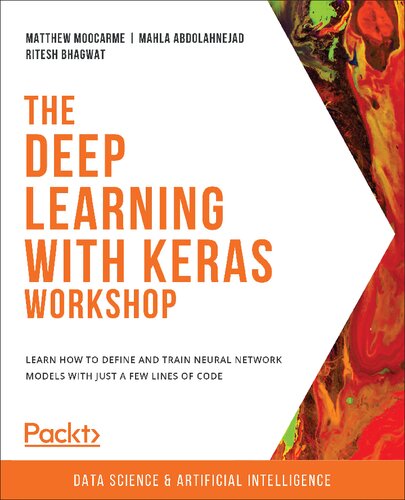

Most ebook files are in PDF format, so you can easily read them using various software such as Foxit Reader or directly on the Google Chrome browser.
Some ebook files are released by publishers in other formats such as .awz, .mobi, .epub, .fb2, etc. You may need to install specific software to read these formats on mobile/PC, such as Calibre.
Please read the tutorial at this link: https://ebookbell.com/faq
We offer FREE conversion to the popular formats you request; however, this may take some time. Therefore, right after payment, please email us, and we will try to provide the service as quickly as possible.
For some exceptional file formats or broken links (if any), please refrain from opening any disputes. Instead, email us first, and we will try to assist within a maximum of 6 hours.
EbookBell Team

4.8
74 reviewsDiscover how to leverage Keras, the powerful and easy-to-use open source Python library for developing and evaluating deep learning models
Key FeaturesNew experiences can be intimidating, but not this one! This beginner's guide to deep learning is here to help you explore deep learning from scratch with Keras, and be on your way to training your first ever neural networks.
What sets Keras apart from other deep learning frameworks is its simplicity. With over two hundred thousand users, Keras has a stronger adoption in industry and the research community than any other deep learning framework.
The Deep Learning with Keras Workshop starts by introducing you to the fundamental concepts of machine learning using the scikit-learn package. After learning how to perform the linear transformations that are necessary for building neural networks, you'll build your first neural network with the Keras library. As you advance, you'll learn how to build multi-layer neural networks and recognize when your model is underfitting or overfitting to the training data. With the help of practical exercises, you'll learn to use cross-validation techniques to evaluate your models and then choose the optimal hyperparameters to fine-tune their performance. Finally, you'll explore recurrent neural networks and learn how to train them to predict values in sequential data.
By the end of this book, you'll have developed the skills you need to confidently train your own neural network models.
What you will learnIf you know the basics of data science and machine learning and want to get started with advanced machine learning technologies like artificial neural networks and deep learning, then this is the book for you. To grasp the concepts explained in this deep learning book more effectively, prior experience in Python programming and some familiarity with statistics and logistic regression are a must.
Table of Contents